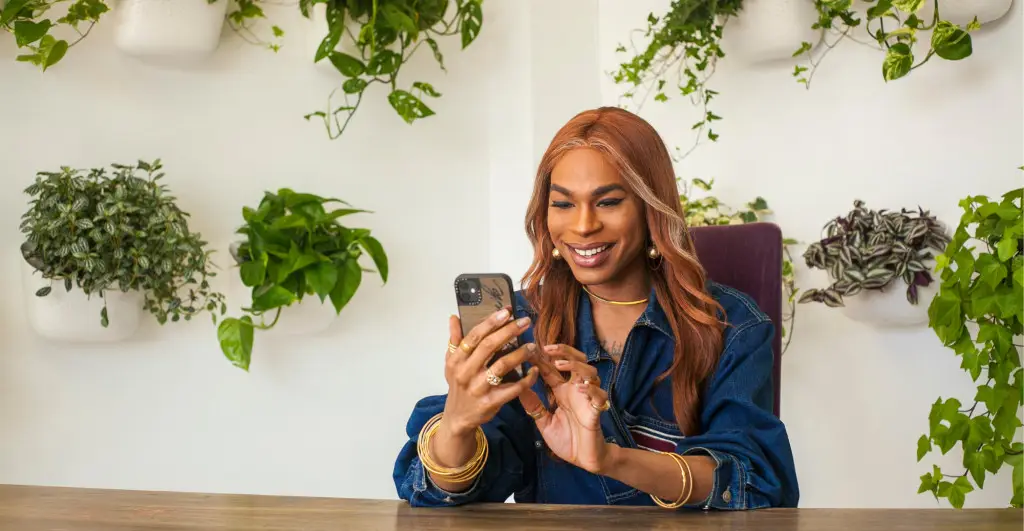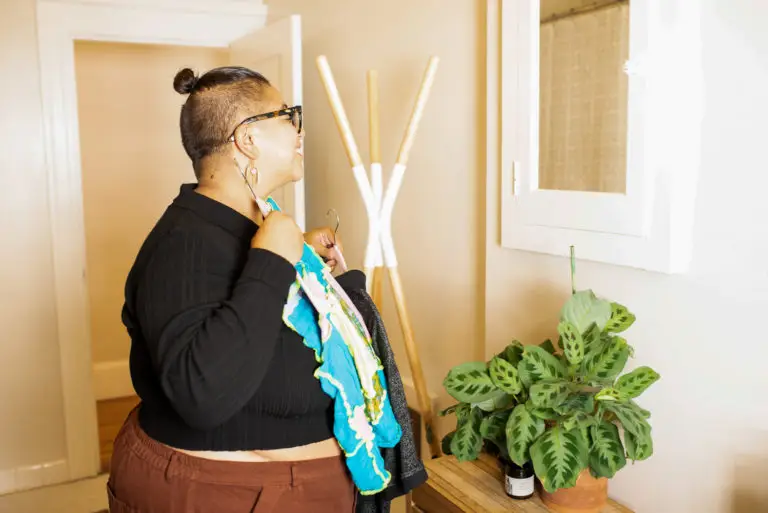By: Cairo Levias (they/them)
Wearing a bra for the first time is a really exciting moment. If you are taking estrogen as a gender-affirming medication, breast development is probably in your future. The full expression of this powerful hormone takes about 3 years to help your body grow breasts. You can learn more about the stages of breast development on E in this article.
As your chest develops, you might want to start wearing a bra. Bra shopping is a feminine rite of passage in our culture. Going to the lingerie shop for the first time, getting measured, and picking out your favorites are all big moments for many femmes. Not every woman, transfeminine person, or nonbinary person with breasts wants or needs to wear a bra. (Seriously, it’s a personal decision and you define your own womanhood.) But it is also just as OK to really love lingerie and love feeling that femme side of yourself.
Lots of folks who take E start their transition long before they begin hormones. Changing your name and pronouns, dressing in a more feminine way, styling your makeup and hair differently, tucking, and other affirming choices are often things we try prior to seeking an estrogen prescription. The point is, gender-affirming hormone therapy (GAHT, also called HRT or hormone replacement therapy) isn’t the be-all, end-all of gender transition. It’s really important, but it isn’t necessarily “the beginning” of your transition. You get to decide what that moment is. Trying on clothes that make you feel beautiful is a powerful experience, no matter what your body looks like or who you’ve shared your identity with.
Before you start shopping, read this
Finding the right bra that fits like a dream takes some exploration but it doesn’t have to be overwhelming. Thankfully, the internet has made things a lot easier for people on this journey. Putting on a bra to support, decorate, or celebrate your growing breasts might seem like a small step—especially if you’ve worn a bra before, experimented with forms and padding, or played with different types of femme gender expression. All the same, you might find that bra shopping for your new breasts adds a new found feeling of gender euphoria.
I think of bra shopping as finding yet another level to your beauty. In turn, that can have a lasting positive effect on your mental health.
There are some websites that can help you get started, but here are the basics. Bra sizing is pretty much universal. It’s not like clothing brand sizes, where a size M in one brand is an XL in another. Your bra size in one brand is most likely going to be the same anywhere you shop. When you pay for a bra, you are paying for quality, design, and materials. You can get a bra for only a few dollars at a thrift store—places like Goodwill often sell overstock or deadstock. You can also shop at high-end places if you love imported silk and fancy embroidery. Whatever your look and your budget, it’ll be easier to pick something if you know your size. Let’s get started!
How to measure yourself for a bra
Typically, figuring out your bra size starts with a snug measurement of your ribcage and your bust. Get a soft tape measure and a friend to help if you have trouble reaching all the way around. Measuring yourself in front of a mirror can help, too. If you don’t have a tape measure, you can cheat and use a ribbon or soft piece of string. You’ll mark the string and then measure it with a ruler. (Be really mindful when you do this and always double-check your measurements.)
Start by measuring your ribcage. Put your measuring tape on your body in the center of your ribs, just under your breasts. Keeping the tape flat and smooth, wrap it around your torso. It can be helpful to have a friend make sure your tape isn’t drooping down or pulling up in the back. Also, it can be tempting to make the tape tighter or looser. Don’t do that! If you want your bra to fit and be comfortable, you need an accurate measurement. A bra is not like squeezing into super-tight jeans. It’s not like a binder, either! It is a garment that is designed to support your body and fit like a second skin.
I suggest measuring your band twice, just to make sure you got it right. Don’t hold your breath, just breathe naturally. Remember that bras are stretchy, so if you’re off by a quarter inch, that’s fine. You want it to be snug, not strangling!
Next, measure your bust. The “bust” measurement is what it’s called when you measure around your breasts and your back. Even if you aren’t super big up top, that’s OK! You still have a bust. One of my nonbinary friends got top surgery and his bra size is 32AA now. He may be “flat,” but when he wears a bra, he has a cup size!
When you measure your bust, use the same method as when you measured your band. Loop the measuring tape around your back and then bring the ends together in the front. Again, don’t pull too tight. (If you want a super sexy, push-up style bra, you can get a bra that is adjustable, has padding, or is designed to give you cleavage. Don’t buy a smaller bra size just for the push-up effect!) Try to measure at the fullest part of your bust. So, depending on your breast development, that can be higher on your breast or lower. Lots of people assume that the fullest part of the breast is at the nipple, but that isn’t true for everybody. Aim for the area where your breasts are most full and write that number down.
When you have both your band and your bust sizes—and you’ve double-checked them—you are ready to figure out your bra size.
Adding up your band size
Next, you will do a little bit of math to calculate your bra size. Take your band size and round it up to the nearest whole number. For example, if you measured your band and got 38.5 inches, you will round up to 39 inches. If you measured and got 30.75 inches, round up to 31 inches. If the number you got is even, add four inches; if the number is odd, add five inches. So, if you are starting with 31 inches, you add 5 and get a band size of 36. If you are starting with 38 inches, you’ll add 4 and get a band size of 42.
If this seems confusing, don’t worry—it’s not you. Bra sizing can feel very complicated. If you absolutely can’t figure out your band and cup size, that is OK. You might feel more comfortable having a salesperson measure you or a friend who knows what she’s doing. If that doesn’t feel like an option, try your best to find a size to start with. You can always try on multiple sizes of bra and figure out which one works best for you.
The second half of the bra size is the cup. This part is way less complicated. You’re almost there!
What do the letters and numbers mean?
Let’s start with a basic bra size calculator. When you hear sizes like “34B,” that is a size that describes the two parts of the bra: the cup and the band. Your band size is literally the size of your band, which is the part of the bra that wraps around your body. Your cup size is the difference between your bust size and your band size.
For example, If you wear a 34B, it means that your ribcage is 30 inches around. (The extra 4 inches is added for the tightness adjustments on the clasp of the bra.) The B in this size would represent the cup size of your actual breast. I’ll include this chart to make that distinction a little easier.
Difference | 0” | 1” | 2” | 3” | 4” | 5” | 6” |
Cup size | AA | A | B | C | D | DD/E | DDD/F |
To get your cup size, take your original two numbers from your measurements. Look at the bust size and subtract the band size. The difference between the two is your cup size. This sizing method is best for more lingerie and everyday bras, not sports bras. These are the kind of bras you would typically be wearing under a blouse, t-shirt, or tank top.
Things to know when buying a bra
Another thing to think about when choosing a bra is the amount of support you want and need. Do you want an underwire bra for support or one with no underwire? The bras made without underwire tend to be more comfortable than the bras made with underwire, but it all depends on what you’re looking for. It’s also fine to just wear a sports bra or even no bra at all. Sometimes it depends on your mood, or even what your outfit looks like for the day.
An underwire bra might support bigger breasts better to hold them in place and relieve some of the pressure put on your back with a larger breast size. Most push-up bras have an underwire. So you know, wearing an underwire doesn’t harm your breast tissue. It basically gives your breasts a shelf to “rest” on while you’re wearing a bra.
When you’re bra shopping, it’s best to decide what will best serve your everyday needs. If you want a bra you can wear literally every day, look for a skin tone, smooth bra with a light lining. The bra should have medium width or wide straps to support your breasts. You can get one with removable pads if you want the option for cleavage or a super feminine look. Some bras have a front clasp, which means you put it on like a little vest. The clasp placement doesn’t affect how the bra fits—it’s just an aesthetic choice.
Troubleshooting your bra size and fit
Choosing your first bra is exciting, especially if you’re celebrating new and affirming breast growth. Don’t be shy about trying on lots of different types of bras. You might find that you are more comfortable without an underwire, or that you prefer racer tank style straps to the standard type. Here are some of my tips for troubleshooting as you are shopping for the bra of your dreams.
- If the band size comes out to an uneven number, try the next band size up.
- If your breasts are two different sizes, try to fit the smaller breast.
- If you’re having some trouble finding the perfect fit, try this other method: Go up in cup size and down in band size, or else go down in cup size and up in band size. Mix and match until you find your perfect fit!
- Your bra should feel snug on your ribcage. When you put it on, bend over and pinch the front of the bra. Give it a little shake to allow your breasts to “fall” into the cups. Then stand up straight and assess. If it fits, it will support your breasts, but not be too tight.
- If there are gaps in the cup, it’s most likely too large.
- If you find that the band is riding up in the back and not staying in place, you might try going down a band size.
- Do the straps feel supportive of your breasts without digging into your shoulders? If they feel too tight, you might need to go with a bra with wider straps, or more structure in the cup and band to relieve some of the pressure from the straps. You can also lengthen the straps if you are tall or have a longer torso.
Bra shopping during your gender transition with E
So you know, your cup size and band size may both change over time. If you gain or lose weight or if your body fat shifts during your transition, your band size may increase or change. As your breasts grow, your cup size may also vary. The speed of this change depends on your hormone journey. For most people, breast tenderness comes on in the first few months on E. Adding progesterone can cause breast buds to show up—they can ache or feel “tight” under your skin as they grow. Breast development takes about 3 years for most people, though your experience may be determined by your genetics, body type, and other factors.
With that said, unless you have a gender-confirming top surgery such as a breast lift or breast augmentation, your breasts will not dramatically change size overnight. (If only!)
Your bra size might vary and change for lots of reasons while taking estrogen. If you are also prescribed progesterone, that can affect your breasts (and your bra size) too. Your first bra is a milestone, but remember that it’s one of many. You’ll go shopping for lingerie without a second though as you get more comfortable in your body. The gender euphoria of feeling gorgeous, glamorous, and put together is so affirming! Enjoy every minute on this beautiful journey of yours.
Cairo Levias (they/them) is a model, stylist, muse, and mystic. From walking the runways of New York Fashion Week to designing seasonal narratives for fashion brands, Cairo’s expansive vision extends beyond gender to life’s possibilities. They live with their husband and two perfect kitties.
As the largest provider of gender-affirming care for the trans and nonbinary community, Plume is committed to providing information about many types of information, including questions about hormones like estrogen and testosterone, gender transitioning tips and experiences, and guidance on social transition and self care.
While we strive to include a diverse range of voices and expertise, not everything will be for every person. Each individual’s experience is unique, and the information Plume provides is not intended to be a substitute for professional medical advice, diagnosis, or treatment.
Always first seek the advice of your primary and/or specialist physician, the Plume Care Team, or other qualified health provider with any questions you may have regarding a medical condition, your mental health and emotional needs, or your health care needs regarding gender-affirming hormone therapy. If you are experiencing an emergency, including a mental health crisis, call 911 or reach out to Trans LifeLine.



